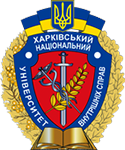Combating economic crime in Ukraine in 1946–1949
Abstract
The author examines the topical and insufficiently researched in historical and legal science issue of the causes and manifestations of economic crime in Ukraine in the first post-war years (1946–1949) and the main aspects of police activity in combating these types of crimes. The departments for combating theft of socialist property and speculation were responsible for combating economic crime. In 1947, the Department for combating the theft of socialist property of the Main Police Department was reorganised into the Administration. Taking advantage of the consumer goods shortage, which reached its peak in the first post-war years (1946–1949), and the circumstances created by the famine of 1946–1947, criminals stole grain, robbed food and industrial warehouses, and resold goods at inflated prices (speculation). The situation with economic crime was particularly difficult in early 1947, when the sowing campaign was underway. The most common crimes were the following: 1) maliciously delaying the repair of agricultural machinery, allegedly due to the lack of spare parts and specialists; 2) theft of grain during its transportation and sowing by persons responsible for this (weighers, field crew leaders, guards); 3) theft of seeds and fuel by security guards; 4) theft and embezzlement of seeds by officials of collective and state farms and subsidiary farms; 5) theft of seed by reducing the seeding rate and theft of fuel due to lack of control over its consumption; 6) theft of seeds by employees of storage facilities with their subsequent resale at markets at speculative prices; 7) creation of surplus seeds by weighing, moistening, writing off for drying, and increasing waste during sorting. The monetary reform in December 1947 and the abolition of the ration card system reduced the overall number of crimes related to the theft of socialist property to a certain extent, as these measures eliminated such crimes as speculation in food and commodity cards and the production of counterfeit cards and food coupons. In order to improve the situation, the Ministry of Internal Affairs demanded that work on the theft of socialist property be intensified on the ground, and that more active agent work be carried out in this area.
Downloads
References
Bandurka, O. M. (2022). From general secretaries to Ministers of Internal Affairs. Maidan.
Bilas, I. H. (1994). Repressive and punitive system in Ukraine. 1917–1953: Socio-political and historical-legal analysis (Book 2). Lybid; Army of Ukraine.
Bortnyk, O. M., & Grechenko, V. A. (2019). Organization and activity of militia in the Ukrainian SSR in 1947: basic aspects. Legal Horizons, 17(30), 7–13. https://doi.org/10.21272/legalhorizons.2019.i17.p7.
Brusakova, O. V., & Hrechenko, V. A. (2022). Legal foundations of the organization and activity of the Ukrainian SSR police in 1949–1950s. Law and Safety, 2(85), 121–130. https://doi.org/10.32631/pb.2022.2.11.
Brusakova, O., & Grechenko, V. (2022). Combating crime in Ukraine after the Second World War (1946–1948). In M. Bezdolnyi, V. Bondar, S. Dereviankin et al., Scientific Foundations of State and Law (pp. 147–164). Primedia eLaunch.
Grechenko, V. A. (Ed.). (2021). Leaders of the Kharkiv militia/police (1918–2021): historical and legal research. Maidan.
Grechenko, V. A., & Yarmysh, O. N. (2019). Organization and activities of the Ukrainian SSR militia in 1951. Nauka ì pravoohorona, 2(44), 33-44. https://doi.org/10.36486/np.2019.2.03.
Herus, M. M. (2019). Criminal justice in the Ukrainian SSR in the post-war period (1945–1958): historical and legal research [Doctoral dissertation, Kharkiv National University of Internal Affairs].
Lahosha, M. M. (2000). Militia of Ukraine in 1945–1953 [Candidate thesis, Donetsk State University].
Okipniuk, V. T. (2019). Soviet state security agencies in Ukraine during theeign of the totalitarian regime (1929–1953). OLDI-PLUS.
Prystaiko, O. V. (2021). PCIA-MIA of the Ukrainian SSR (1934–1954): structural construction and functions (historical and legal research) [Doctoral dissertation, National Academy of Internal Affairs].
Sabluk, S. A. (2017). Criminal and legal control of crime in Ukraine in 1922–1960 [Doctoral dissertation, Kyiv National Academy of Internal Affairs].
Smirnov, Yu. O., Mykhailenko, P. P., Sviatotskyi, O. D., & Anufriiev, M. I. (2002). Militia of Ukraine: historical sketch, portraits, events (Yu. O. Smirnov, Ed.). In Yure.
Sokurenko, V. V., Bandurka, O. M., & Grechenko, V. A. (2017). Training of law enforcement officers in Kharkiv: 100 years of history (1917–2017): to the 100th anniversary of the events of the Ukrainian Revolution. Golden Mile.
Voitsekhovskyi, M. M. (2001). Legal foundations of the organization andactivity of the militia of Ukraine in the post-war period (1946–1953) [Candidate dissertation, Kharkiv National University of Internal Affairs].
Vorozhko, V. P. (2015). Formation and development of the system of protection of state secrets in Soviet Ukraine (1919–1954) [Candidate dissertation, Pereiaslav-Khmelnytskyi Hryhorii Skovoroda State Pedagogical University].
Copyright (c) 2023 V. A. Grechenko

This work is licensed under a Creative Commons Attribution 4.0 International License.



